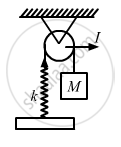Advertisements
Advertisements
प्रश्न
Solve the previous problem if the pulley has a moment of inertia I about its axis and the string does not slip over it.
उत्तर

Let us try to solve the problem using energy method.
If δ is the displacement from the mean position then, the initial extension of the spring from the mean position is given by,
\[\delta =\] \[\frac{mg}{k}\]
Let x be any position below the equilibrium during oscillation.
Let v be the velocity of mass m and ω be the angular velocity of the pulley.
If r is the radius of the pulley then
v = rω
As total energy remains constant for simple harmonic motion, we can write:
\[\frac{1}{2}M v^2 + \frac{1}{2}I \omega^2 + \frac{1}{2}k\left[ (x + \delta )^2 - \delta^2 \right] - Mgx = \text { Constant }\]
\[ \Rightarrow \frac{1}{2}M v^2 + \frac{1}{2}I \omega^2 + \frac{1}{2}k x^2 + kxd - Mgx = \text { Constant }\]
\[ \Rightarrow \frac{1}{2}M v^2 + \frac{1}{2}I\left( \frac{v^2}{r^2} \right) + \frac{1}{2}k x^2 = \text { Constant } \left[ \because \delta = \frac{Mg}{k} \right]\]
By taking derivatives with respect to t, on both sides, we have:
\[Mv . \frac{dv}{dt} + \frac{I}{r^2}v . \frac{dv}{dt} + kx\frac{dx}{dt} = 0\]
\[Mva + \frac{I}{r^2}va + kxv = 0 \left( \because v = \frac{dx}{dt} \text { and }a = \frac{dv}{dt} \right)\] \[a\left( M + \frac{I}{r^2} \right) = - kx \] \[ \Rightarrow \frac{a}{x} = \frac{k}{M + \frac{I}{r^2}} = \omega^2 \] \[T = \frac{2\pi}{\omega}\]
\[ \Rightarrow T = 2\pi\sqrt{\frac{M + \frac{I}{r^2}}{k}}\]
APPEARS IN
संबंधित प्रश्न
A particle is in linear simple harmonic motion between two points, A and B, 10 cm apart. Take the direction from A to B as the positive direction and give the signs of velocity, acceleration and force on the particle when it is
(a) at the end A,
(b) at the end B,
(c) at the mid-point of AB going towards A,
(d) at 2 cm away from B going towards A,
(e) at 3 cm away from A going towards B, and
(f) at 4 cm away from B going towards A.
A particle executes simple harmonic motion with an amplitude of 10 cm. At what distance from the mean position are the kinetic and potential energies equal?
The equation of motion of a particle started at t = 0 is given by x = 5 sin (20t + π/3), where x is in centimetre and t in second. When does the particle
(a) first come to rest
(b) first have zero acceleration
(c) first have maximum speed?
The pendulum of a clock is replaced by a spring-mass system with the spring having spring constant 0.1 N/m. What mass should be attached to the spring?
A block suspended from a vertical spring is in equilibrium. Show that the extension of the spring equals the length of an equivalent simple pendulum, i.e., a pendulum having frequency same as that of the block.
A body of mass 2 kg suspended through a vertical spring executes simple harmonic motion of period 4 s. If the oscillations are stopped and the body hangs in equilibrium find the potential energy stored in the spring.
Repeat the previous exercise if the angle between each pair of springs is 120° initially.
Discuss in detail the energy in simple harmonic motion.
Show that for a particle executing simple harmonic motion.
- the average value of kinetic energy is equal to the average value of potential energy.
- average potential energy = average kinetic energy = `1/2` (total energy)
Hint: average kinetic energy = <kinetic energy> = `1/"T" int_0^"T" ("Kinetic energy") "dt"` and
average potential energy = <potential energy> = `1/"T" int_0^"T" ("Potential energy") "dt"`
When the displacement of a particle executing simple harmonic motion is half its amplitude, the ratio of its kinetic energy to potential energy is ______.
If a body is executing simple harmonic motion and its current displacements is `sqrt3/2` times the amplitude from its mean position, then the ratio between potential energy and kinetic energy is:
A body is executing simple harmonic motion with frequency ‘n’, the frequency of its potential energy is ______.
A body is executing simple harmonic motion with frequency ‘n’, the frequency of its potential energy is ______.
Motion of an oscillating liquid column in a U-tube is ______.
Draw a graph to show the variation of P.E., K.E. and total energy of a simple harmonic oscillator with displacement.
Find the displacement of a simple harmonic oscillator at which its P.E. is half of the maximum energy of the oscillator.
A mass of 2 kg is attached to the spring of spring constant 50 Nm–1. The block is pulled to a distance of 5 cm from its equilibrium position at x = 0 on a horizontal frictionless surface from rest at t = 0. Write the expression for its displacement at anytime t.
An object of mass 0.5 kg is executing a simple Harmonic motion. Its amplitude is 5 cm and the time period (T) is 0.2 s. What will be the potential energy of the object at an instant t = `T/4` s starting from the mean position? Assume that the initial phase of the oscillation is zero.
A particle undergoing simple harmonic motion has time dependent displacement given by x(t) = A sin`(pit)/90`. The ratio of kinetic to the potential energy of this particle at t = 210s will be ______.
